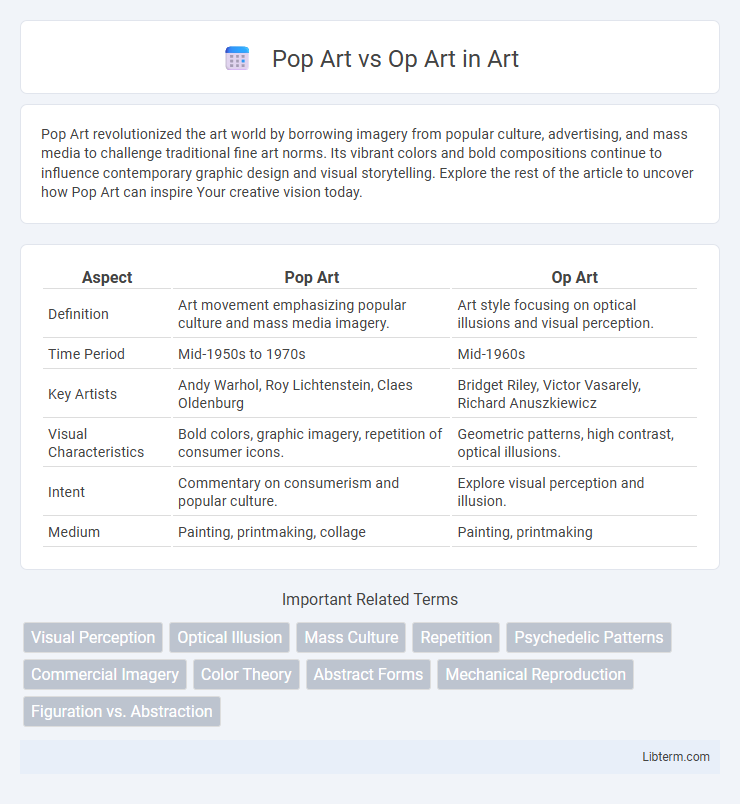Pop Art revolutionized the art world by borrowing imagery from popular culture, advertising, and mass media to challenge traditional fine art norms. Its vibrant colors and bold compositions continue to influence contemporary graphic design and visual storytelling. Explore the rest of the article to uncover how Pop Art can inspire Your creative vision today.
Table of Comparison
| Aspect | Pop Art | Op Art |
|---|---|---|
| Definition | Art movement emphasizing popular culture and mass media imagery. | Art style focusing on optical illusions and visual perception. |
| Time Period | Mid-1950s to 1970s | Mid-1960s |
| Key Artists | Andy Warhol, Roy Lichtenstein, Claes Oldenburg | Bridget Riley, Victor Vasarely, Richard Anuszkiewicz |
| Visual Characteristics | Bold colors, graphic imagery, repetition of consumer icons. | Geometric patterns, high contrast, optical illusions. |
| Intent | Commentary on consumerism and popular culture. | Explore visual perception and illusion. |
| Medium | Painting, printmaking, collage | Painting, printmaking |
Introduction to Pop Art and Op Art
Pop Art emerged in the mid-1950s, characterized by bold colors, graphic imagery, and themes drawn from popular culture, consumerism, and mass media. Op Art, originating in the 1960s, focuses on optical illusions, geometric patterns, and visual perception, creating dynamic effects that challenge viewers' visual experience. Both movements revolutionized contemporary art by shifting attention to everyday imagery and perceptual engagement.
Origins and Historical Context
Pop Art originated in the mid-1950s in Britain and the late 1950s in the United States, emerging as a reaction against the dominant Abstract Expressionism and drawing inspiration from popular culture, advertising, and mass media. Op Art, short for Optical Art, developed in the 1960s primarily in Europe and the United States, focusing on visual perception and optical illusions through precise geometric patterns and contrasting colors. Both movements reflect the socio-economic changes of the post-war era, with Pop Art commenting on consumerism and media saturation, while Op Art explored scientific principles of vision and the psychology of visual experience.
Key Artists and Influencers
Pop Art, characterized by its bold imagery and vibrant colors, was led by key artists such as Andy Warhol, Roy Lichtenstein, and Claes Oldenburg, who drew inspiration from consumer culture and mass media. Op Art, known for its optical illusions and geometric patterns, features influential figures like Bridget Riley and Victor Vasarely, pioneers in manipulating visual perception through precise arrangements of shapes and colors. Both movements significantly impacted contemporary art by challenging traditional aesthetics and exploring new visual experiences.
Defining Characteristics of Pop Art
Pop Art is characterized by its bold use of vibrant colors, incorporation of popular culture imagery, and emphasis on mass media and consumer products. This movement often features techniques such as silkscreen printing and repetitive patterns to challenge traditional fine art boundaries. Iconic artists like Andy Warhol and Roy Lichtenstein exemplify Pop Art's fusion of commercial aesthetics with artistic expression.
Defining Characteristics of Op Art
Op Art, short for Optical Art, is defined by its use of geometric shapes, high contrast patterns, and precise color manipulation to create visual illusions that appear to move or vibrate. This art movement emphasizes the viewer's perception, often employing black and white or vibrant color contrasts to produce effects such as flickering, warping, or pulsating surfaces. Unlike the narrative and popular culture references found in Pop Art, Op Art is centered on visual experience and perceptual interaction.
Techniques and Materials Used
Pop Art employs bold colors, commercial imagery, and techniques such as silkscreen printing and collage to reflect mass culture, often using materials like acrylic paint and synthetic polymer paints on canvas. Op Art focuses on optical illusions and visual perception through precise geometric patterns, utilizing techniques like meticulous hand-painting or printing with materials such as black and white paints or inks on flat surfaces. Both movements emphasize different sensory effects, with Pop Art appealing to cultural commentary and Op Art engaging viewers through dynamic visual vibrations.
Visual Effects and Viewer Experience
Pop Art captivates viewers through bold colors, iconic imagery, and cultural references that evoke familiarity and emotional engagement. Op Art creates dynamic visual effects using precise patterns, optical illusions, and contrasting tones that challenge perception and induce a sense of movement or vibration. The immersive experience in Pop Art is rooted in its narrative and symbolism, while Op Art focuses on stimulating the viewer's visual processing and spatial awareness.
Cultural Impact and Legacy
Pop Art revolutionized visual culture by challenging traditional fine art through bold imagery and mass media references, influencing advertising, fashion, and contemporary art worldwide. Op Art reshaped perceptions of visual experience via optical illusions and geometric abstraction, impacting graphic design, architecture, and popular culture in the 1960s and beyond. Both movements left enduring legacies by redefining artistic boundaries and inspiring successive generations in creative expression and visual communication.
Pop Art vs Op Art: Key Differences
Pop Art emphasizes bold colors, popular culture imagery, and mass media themes, while Op Art focuses on optical illusions and visual perception through precise patterns and contrasting colors. Pop Art uses recognizable objects and celebrity icons to critique consumerism, whereas Op Art creates dynamic visual effects that manipulate viewers' perception without specific cultural references. The key difference lies in Pop Art's narrative and symbolic content versus Op Art's abstract, perceptual experience.
Conclusion: Influence on Contemporary Art
Pop Art and Op Art both significantly shaped contemporary art by challenging traditional aesthetics and expanding visual language. Pop Art's bold use of popular culture and mass media imagery redefined artistic subject matter, inspiring movements like postmodernism and street art. Op Art's exploration of optical illusions and perceptual effects influenced digital art, design, and interactive installations, emphasizing viewer engagement and dynamic visual experiences.
Pop Art Infographic

 libterm.com
libterm.com